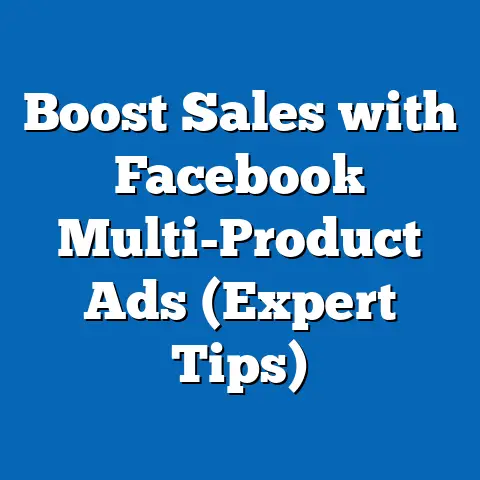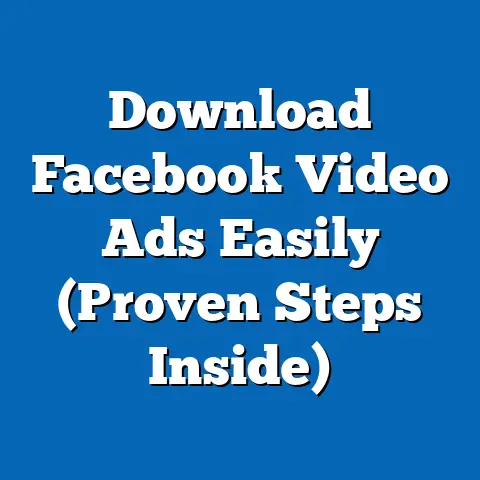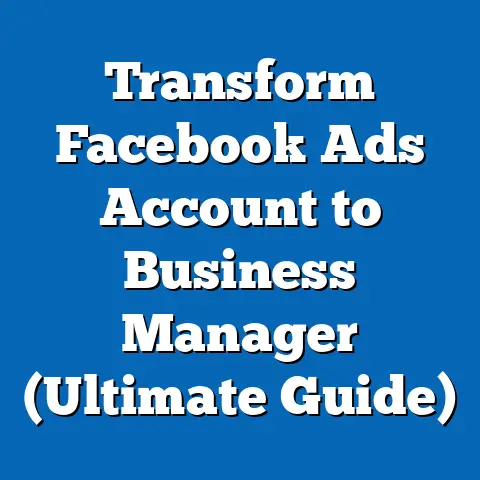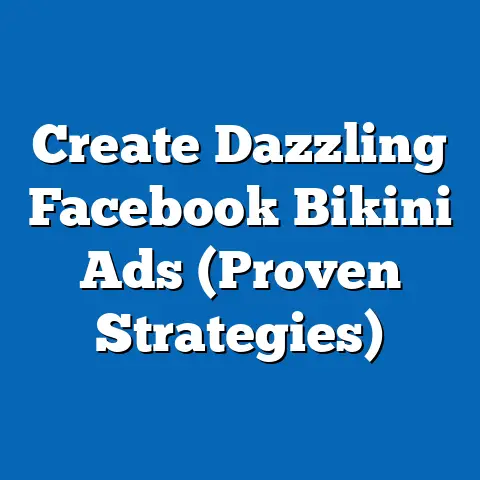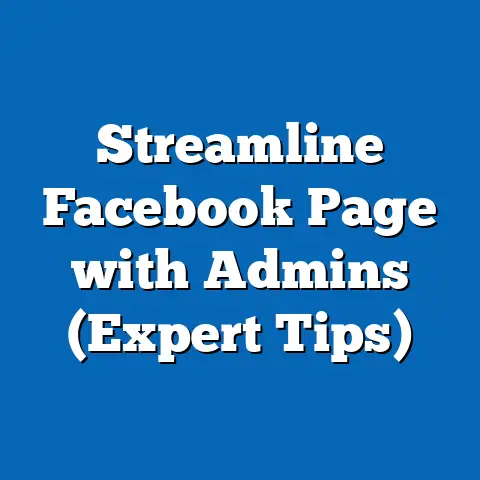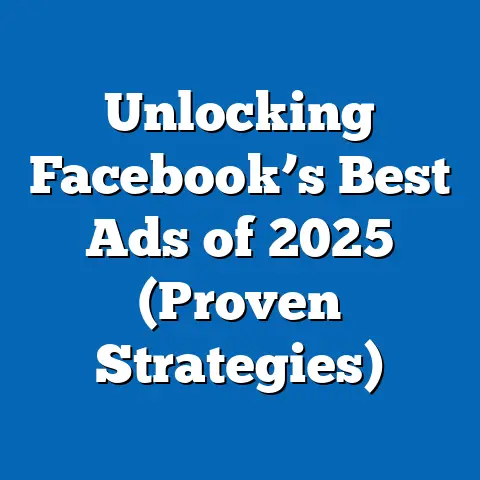Mastering App Ads on Facebook (Expert Strategies Revealed)
In the realm of digital marketing, mastering Facebook app ads isn’t just an option—it’s a necessity for businesses looking to thrive in a saturated market. I’ve seen countless apps struggle to gain traction simply because they weren’t leveraging the power of Facebook advertising effectively. Think of Facebook as a giant, hyper-targeted billboard, and app ads are your message to the world.
Facebook, with its billions of users, offers an unparalleled platform for app promotion. Its advanced targeting capabilities allow you to reach the precise audience most likely to download, engage with, and ultimately love your app. App ads can drive downloads, increase engagement, and boost overall app revenue, but only if you know how to wield them effectively.
This article isn’t just another generic guide. I’m going to share expert strategies that I’ve personally used to elevate app visibility and performance on Facebook, turning casual browsers into loyal users. Get ready to unlock the full potential of your app marketing efforts and position yourself for success in a competitive environment.
Understanding the Facebook App Ads Landscape
The Evolution of Facebook Advertising
Facebook advertising has come a long way since its early days. It started as a simple way to boost posts and has evolved into a sophisticated, data-driven platform with a multitude of ad formats and targeting options. The shift towards mobile has been particularly significant for app promotion.
I remember when mobile ads were an afterthought. Now, they’re the primary focus. According to Statista, mobile advertising spending is projected to reach over $339 billion in 2023, a testament to the power of reaching users on their smartphones. For app developers, this means Facebook’s mobile-first approach is a goldmine.
Facebook’s algorithm has also become increasingly intelligent, learning from user behavior and delivering ads to the most receptive audiences. This evolution demands that marketers stay updated with the latest trends and best practices to maximize their ROI.
Takeaway: Keep an eye on the ever-changing landscape of Facebook advertising. What worked last year might not work today.
Types of App Ads
Facebook offers several ad formats specifically designed for app promotion, each serving a distinct purpose:
- App Install Ads: These are the bread and butter of app advertising, designed to drive downloads directly from the Facebook platform. They typically feature a compelling visual, persuasive ad copy, and a clear “Install Now” call-to-action.
- App Engagement Ads: If you’re looking to re-engage existing users, app engagement ads are the way to go. These ads encourage users who already have your app installed to take specific actions, such as completing a level, making a purchase, or inviting friends.
- App Retargeting Ads: Retargeting ads are perfect for reaching users who have interacted with your app or website but haven’t yet converted. These ads can be tailored to show specific products or features that the user has previously shown interest in.
For example, if you’re launching a new mobile game, App Install Ads would be your primary focus to acquire new users. Once you have a substantial user base, App Engagement Ads can help boost retention and monetization.
Takeaway: Choose the right ad format based on your specific marketing goals. Don’t use a hammer when you need a screwdriver.
Key Metrics to Track
Measuring the success of your Facebook app ads requires a keen eye on several key metrics:
- Cost Per Install (CPI): This metric tells you how much you’re paying for each app install generated by your ads. A lower CPI generally indicates a more efficient campaign.
- Return on Ad Spend (ROAS): ROAS measures the revenue generated for every dollar spent on advertising. A higher ROAS means your ads are driving profitable results.
- Click-Through Rate (CTR): CTR indicates how often people who see your ad click on it. A higher CTR suggests that your ad creative and targeting are resonating with your audience.
These metrics are interconnected. A high CTR can lead to a lower CPI, and a lower CPI can contribute to a higher ROAS. I always tell my clients to look at the bigger picture. Don’t get fixated on a single metric.
Takeaway: Track and analyze your key metrics regularly to identify areas for improvement and optimize your campaigns for maximum ROI.
Crafting Compelling Ad Creative
The Importance of Eye-Catching Visuals
In the fast-paced world of social media, visuals are king. Your ad has mere seconds to capture a user’s attention as they scroll through their newsfeed. A visually appealing ad can make all the difference between a scroll-past and a click-through.
When designing visuals, consider these tips:
- Use high-quality images or videos: Avoid blurry or pixelated visuals.
- Showcase your app’s best features: Highlight what makes your app unique and valuable.
- Reflect your brand identity: Maintain consistency in colors, fonts, and overall style.
I once worked with a client whose app visuals were outdated and uninspired. After revamping their ad creative with fresh, eye-catching designs, we saw a 50% increase in CTR.
Takeaway: Invest time and resources in creating visually stunning ads that grab attention and communicate your app’s value proposition.
Writing Persuasive Ad Copy
Compelling ad copy is just as important as eye-catching visuals. Your ad copy should be concise, persuasive, and relevant to your target audience. It should clearly communicate the benefits of your app and include a strong call-to-action (CTA).
Here are some tips for writing effective ad copy:
- Highlight the value proposition: Explain what problem your app solves or what benefits it offers.
- Use clear and concise language: Avoid jargon and technical terms.
- Include a strong CTA: Tell users exactly what you want them to do (e.g., “Install Now,” “Download Today,” “Learn More”).
I’ve found that using power words (e.g., “Free,” “Exclusive,” “Limited Time”) can significantly boost ad performance.
Takeaway: Craft persuasive ad copy that clearly communicates your app’s value proposition and includes a strong call-to-action.
Utilizing Video Content
Video ads are incredibly effective for showcasing app features and engaging potential users. A well-produced video can demonstrate the functionality and benefits of your app in a way that static images simply can’t.
When creating video content, consider these strategies:
- Keep it short and sweet: Aim for videos that are 15-30 seconds long.
- Focus on the most important features: Highlight what makes your app unique and valuable.
- Include a clear CTA: Tell users what you want them to do after watching the video.
I’ve seen firsthand how video ads can outperform static image ads in terms of engagement and conversions.
Takeaway: Incorporate video content into your Facebook app ads to showcase your app’s features and engage potential users.
Targeting the Right Audience
Defining Your Target Audience
Before launching any ad campaign, it’s crucial to define your target audience. Who are you trying to reach? What are their interests, demographics, and behaviors? Creating detailed buyer personas can help you understand your ideal app user and tailor your ads accordingly.
Consider these factors when defining your target audience:
- Demographics: Age, gender, location, education, income.
- Interests: Hobbies, passions, activities.
- Behaviors: Online habits, purchase history, app usage.
I always recommend conducting thorough market research to gain a deep understanding of your target audience.
Takeaway: Define your target audience based on demographics, interests, and behaviors to ensure your ads are reaching the right people.
Advanced Targeting Options
Facebook offers a range of advanced targeting options that can help you reach your ideal app users more effectively:
- Custom Audiences: Create custom audiences based on your existing customer data, such as email lists or website visitors.
- Lookalike Audiences: Expand your reach by targeting users who are similar to your existing customers.
- Interest-Based Targeting: Target users based on their declared interests and activities on Facebook.
For example, if you’re promoting a fitness app, you could target users who have liked pages related to health and wellness or who have shown interest in fitness equipment.
Takeaway: Leverage Facebook’s advanced targeting options to reach potential app users who are most likely to be interested in your app.
A/B Testing for Audience Segmentation
A/B testing is essential for identifying high-performing audience segments. By testing different audience parameters, you can determine which segments are most responsive to your ads.
Here are some audience segments you can test:
- Age ranges: 18-24, 25-34, 35-44, etc.
- Interests: Fitness, travel, cooking, etc.
- Behaviors: Frequent travelers, online shoppers, mobile gamers, etc.
I recommend testing one variable at a time to accurately measure the impact of each segment.
Takeaway: Use A/B testing to identify high-performing audience segments and optimize your targeting for maximum ROI.
Budgeting and Bidding Strategies
Setting a Realistic Budget
Setting a realistic budget is crucial for the success of your Facebook app ads. Your budget should be based on your app goals, audience size, and competition.
Consider these factors when setting your budget:
- App goals: What do you want to achieve with your ads (e.g., downloads, engagement, revenue)?
- Audience size: How many people are you trying to reach?
- Competition: How much are your competitors spending on Facebook ads?
I always advise clients to start with a smaller budget and gradually increase it as they see positive results.
Takeaway: Set a realistic budget based on your app goals, audience size, and competition, and be prepared to adjust it as needed.
Bidding Strategies That Work
Facebook offers several bidding strategies, each with its own advantages and disadvantages:
- Cost Per Click (CPC): You pay each time someone clicks on your ad.
- Cost Per Thousand Impressions (CPM): You pay for every 1,000 times your ad is shown.
- Cost Per Acquisition (CPA): You pay each time someone takes a desired action, such as installing your app.
The best bidding strategy depends on your specific goals and budget. If you’re focused on driving traffic to your app’s landing page, CPC might be the best option. If you’re focused on driving app installs, CPA might be more effective.
Takeaway: Choose the bidding strategy that aligns with your specific goals and budget.
Scaling Your Campaigns
Scaling successful campaigns requires careful monitoring and adjustments. You don’t want to increase your budget too quickly and risk sacrificing performance.
Here are some tips for scaling your campaigns:
- Monitor your budget allocation: Make sure your budget is being allocated efficiently across different ad sets.
- Adjust bids accordingly: Increase bids for high-performing ad sets and decrease bids for low-performing ad sets.
- Expand your targeting: Explore new audience segments to reach a wider audience.
I’ve found that gradual scaling is the most effective approach.
Takeaway: Scale your campaigns gradually and monitor your budget allocation and bids to maintain optimal performance.
Analyzing and Optimizing Campaign Performance
The Role of Facebook Ads Manager
Facebook Ads Manager is your go-to tool for tracking campaign performance. It provides a wealth of data and insights that can help you optimize your ads for maximum ROI.
With Ads Manager, you can:
- Track key metrics: CPI, ROAS, CTR, etc.
- Analyze audience performance: Identify which audience segments are most responsive to your ads.
- Adjust bids and budgets: Optimize your spending for maximum efficiency.
I spend hours each week poring over Ads Manager data to identify opportunities for improvement.
Takeaway: Familiarize yourself with Facebook Ads Manager and use it to track and analyze your campaign performance.
Key Performance Indicators (KPIs) to Monitor
As mentioned earlier, several KPIs are crucial for app ads. Here’s a quick recap:
- Cost Per Install (CPI): How much are you paying for each app install?
- Return on Ad Spend (ROAS): How much revenue are you generating for every dollar spent?
- Click-Through Rate (CTR): How often are people clicking on your ads?
In addition to these KPIs, you should also monitor:
- Conversion Rate: The percentage of people who click on your ad and then install your app.
- Retention Rate: The percentage of users who continue to use your app over time.
Takeaway: Monitor your KPIs regularly to gauge campaign success and identify areas for improvement.
Continuous Optimization Techniques
Continuous optimization is essential for maintaining peak performance. You should always be testing new ad creative, targeting options, and bidding strategies.
Here are some optimization techniques you can use:
- A/B test different ad creative: Test different images, videos, and ad copy to see what resonates best with your audience.
- Refine your targeting: Experiment with different audience segments to identify high-performing groups.
- Adjust your bidding strategy: Try different bidding strategies to see which one delivers the best results for your budget.
I’ve found that even small tweaks can have a significant impact on campaign performance.
Takeaway: Continuously optimize your campaigns based on performance data to maximize your ROI. Stay agile and adapt to what the data is telling you.
Conclusion
Mastering Facebook app ads is no longer optional in today’s competitive digital landscape. It’s a critical component of any successful app marketing strategy. By implementing the expert strategies I’ve shared, you can unlock the full potential of your app marketing efforts on Facebook and position yourself for sustained growth. Remember to focus on compelling creative, targeted audiences, realistic budgets, and continuous optimization. With the right approach, you can achieve remarkable results and drive sustained growth through effective app advertising. Now, go out there and make your app a Facebook advertising success story!

